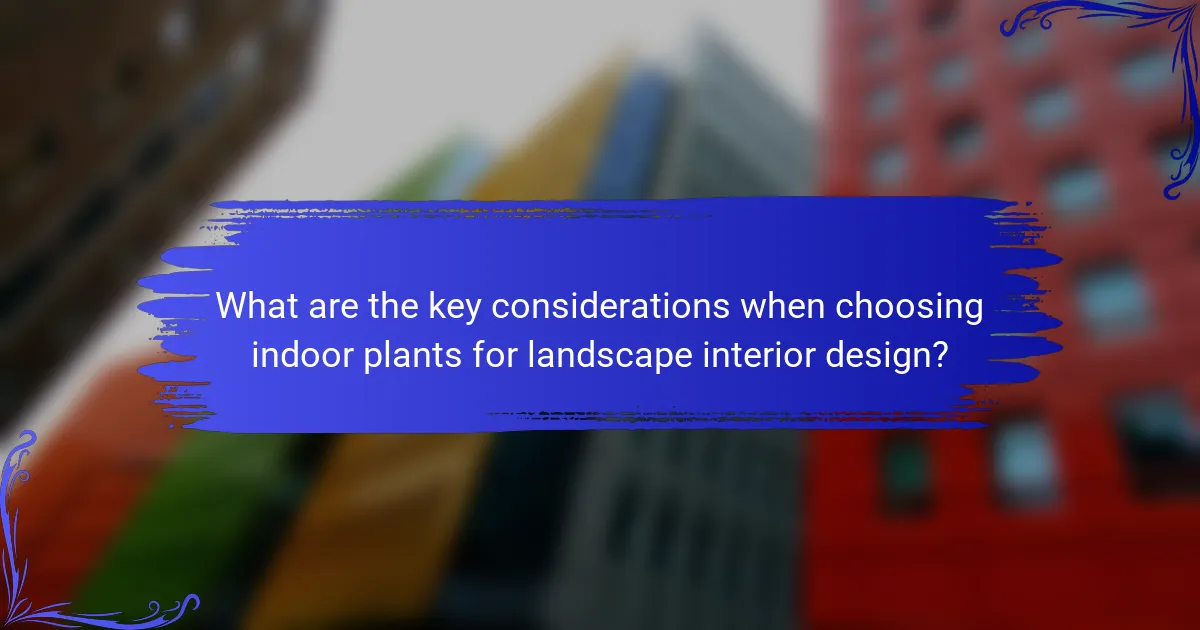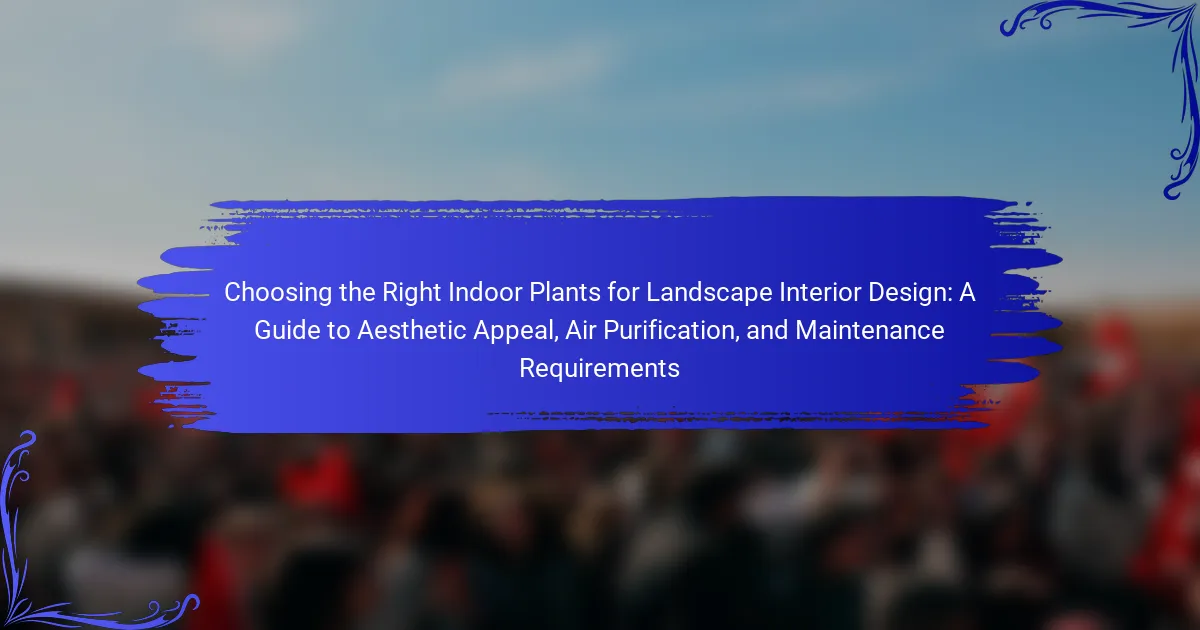Choosing the right indoor plants is crucial for effective landscape interior design, as it involves several key considerations. Light requirements vary among plants, with some thriving in low light and others needing bright conditions. Humidity levels also play a significant role, as certain plants require high humidity while others prefer drier settings. Maintenance needs differ, with some plants demanding frequent care and others being low-maintenance. Additionally, the aesthetic appeal of plants must align with the interior decor, and their air purification capabilities can further enhance indoor air quality, making them more desirable choices.

What are the key considerations when choosing indoor plants for landscape interior design?
Key considerations when choosing indoor plants for landscape interior design include light requirements, humidity levels, and maintenance needs. Different plants thrive in varying light conditions, such as low, medium, or bright light. Humidity is crucial; some plants require high humidity, while others prefer drier environments. Maintenance is also essential; some plants need frequent watering and pruning, while others are more low-maintenance. Additionally, aesthetic appeal plays a significant role. The visual harmony of plants with the interior decor must be considered. Finally, air purification capabilities can enhance indoor air quality, making certain plants more desirable.
How do aesthetic appeal and indoor plants influence interior spaces?
Aesthetic appeal and indoor plants significantly enhance interior spaces. Indoor plants introduce natural beauty and color, improving visual interest. They create a calming atmosphere, which positively affects mood and well-being. Research indicates that greenery can reduce stress levels and increase productivity. A study published in the Journal of Environmental Psychology found that plants in workspaces improve concentration and creativity. Additionally, indoor plants can purify air, contributing to a healthier environment. Their presence also fosters a connection to nature, which is often lacking in urban settings. Overall, the integration of aesthetic appeal and indoor plants transforms and revitalizes interior spaces.
What are the visual elements to consider in plant selection?
The visual elements to consider in plant selection include color, shape, texture, and size. Color influences the overall aesthetic and can create mood. Shape affects the visual interest and can complement other design elements. Texture adds depth and dimension, enhancing the visual appeal. Size impacts the scale of the space and can create focal points. These elements work together to create harmony in interior design. Research shows that plants with varied colors and textures can improve indoor environments.
How can color and texture enhance the overall design?
Color and texture significantly enhance overall design by creating visual interest and depth. Color affects mood and perception. For instance, warm colors like red and yellow can evoke energy, while cool colors like blue and green promote calmness. Texture adds dimension and tactile appeal. Smooth surfaces can convey modernity, while rough textures can evoke a natural, organic feel. When applied to indoor plants, vibrant foliage and varied leaf shapes can transform a space. Research shows that incorporating diverse colors and textures can improve aesthetic satisfaction by up to 60%. This indicates their crucial role in effective design.
What role do indoor plants play in air purification?
Indoor plants play a significant role in air purification. They absorb carbon dioxide and release oxygen through photosynthesis. Certain species can also filter harmful pollutants from the air. Research by NASA identifies plants like the spider plant and peace lily as effective air purifiers. These plants can remove toxins such as formaldehyde and benzene. Studies show that indoor plants can reduce airborne volatile organic compounds. This contributes to improved indoor air quality and overall health. Therefore, incorporating indoor plants can enhance both aesthetics and air quality in interior spaces.
Which plants are known for their air-purifying qualities?
Spider plants, peace lilies, and snake plants are known for their air-purifying qualities. Spider plants remove pollutants like formaldehyde and xylene. Peace lilies can filter out ammonia, benzene, and trichloroethylene. Snake plants are effective at absorbing carbon dioxide and releasing oxygen at night. NASA’s Clean Air Study highlights these plants’ abilities to improve indoor air quality. They are suitable for homes and offices due to their low maintenance needs.
How does air quality impact health and well-being?
Air quality significantly impacts health and well-being. Poor air quality can lead to respiratory issues, including asthma and chronic bronchitis. Pollutants like particulate matter and volatile organic compounds can cause inflammation in the lungs. Long-term exposure may increase the risk of cardiovascular diseases. Studies show that improved air quality contributes to better cognitive function and mood. For instance, a study published in the journal Environmental Health Perspectives found a correlation between cleaner air and reduced anxiety levels. Additionally, indoor plants can enhance air quality by filtering toxins and increasing oxygen levels. Thus, maintaining good air quality is essential for overall health and well-being.
What are the maintenance requirements for indoor plants?
Indoor plants require regular watering, appropriate lighting, and periodic fertilization. Watering needs vary by species, but most indoor plants prefer moist, well-drained soil. Overwatering can lead to root rot, so it’s essential to allow the top inch of soil to dry between waterings.
Lighting is crucial; some plants thrive in bright, indirect light, while others prefer low-light conditions. Positioning plants according to their light needs enhances growth and health.
Fertilization should occur during the growing season, typically spring and summer. A balanced, water-soluble fertilizer can promote healthy growth.
Additionally, regular pruning helps maintain shape and encourages new growth. Dusting leaves keeps plants healthy by allowing better light absorption and reducing pests.
These maintenance practices ensure indoor plants remain vibrant and healthy.
How do light and water needs vary among different plants?
Light and water needs vary significantly among different plants. Some plants thrive in low light conditions, such as snake plants and pothos. These plants require less frequent watering due to their ability to store moisture. Conversely, other plants, like succulents and cacti, need bright light and well-draining soil. They also require less water, as overwatering can lead to root rot.
Tropical plants, such as ferns and peace lilies, prefer indirect light and consistently moist soil. They need more water compared to drought-resistant species. Additionally, flowering plants like orchids often need specific light conditions and regular watering to bloom effectively.
Understanding these variations helps in selecting the right plants for indoor environments. This knowledge ensures optimal growth and maintenance, aligning with aesthetic and air purification goals in landscape interior design.
What are the common challenges in maintaining indoor plants?
Common challenges in maintaining indoor plants include inadequate light, improper watering, and pest infestations. Many indoor plants require specific light conditions to thrive. Insufficient light can lead to stunted growth or leaf drop. Overwatering or underwatering can cause root rot or dehydration. It’s crucial to understand each plant’s watering needs. Additionally, pests like spider mites and aphids can damage plants. Regular monitoring is necessary to catch infestations early. Environmental factors, such as humidity and temperature, also play a significant role. Indoor plants often struggle in dry air or extreme temperatures.
How can one effectively transition from choosing plants to implementing them in design?
To effectively transition from choosing plants to implementing them in design, create a detailed plan that incorporates selected plants into the overall layout. Begin by assessing the space’s light, humidity, and temperature conditions. Next, group plants based on their care requirements and aesthetic qualities. Consider the visual impact of plant placement, ensuring a balance of height, texture, and color. Use design principles such as focal points and symmetry to enhance the arrangement. Finally, implement the design by arranging the plants in their designated spots, taking care to accommodate their growth and maintenance needs. This structured approach ensures a cohesive and functional indoor landscape.
What strategies can enhance the integration of indoor plants into landscape design?
Incorporating indoor plants into landscape design can be enhanced through strategic placement, selection, and maintenance. First, choose plants that thrive in the specific light conditions of the space. For instance, low-light plants like snake plants work well in dim areas. Next, create visual interest by varying plant heights and textures. Use taller plants as focal points and smaller ones for ground cover. Additionally, consider the color palette of the plants to complement the overall design. Grouping plants with similar watering needs simplifies maintenance. Finally, integrate plants into existing structures, like shelves or walls, to maximize space and impact. These strategies collectively improve the aesthetic appeal and functionality of indoor landscapes.
What are the best practices for selecting and caring for indoor plants in landscape design?
Select indoor plants based on light, humidity, and temperature requirements. Choose plants that thrive in the specific conditions of your space. Consider the aesthetic appeal and how plants complement the overall design. Assess the maintenance needs, including watering frequency and potential pest issues. Ensure proper drainage to prevent root rot. Use quality potting soil to support healthy growth. Regularly check for signs of stress or disease in plants. Rotate plants occasionally for even light exposure.
How can one create a balanced plant arrangement?
To create a balanced plant arrangement, select plants of varying heights and shapes. This diversity adds visual interest and prevents monotony. Group plants in odd numbers for a more natural look. Consider the light and water needs of each plant to ensure compatibility. Use a focal point, such as a tall plant, to draw attention. Arrange plants with contrasting colors and textures to enhance appeal. Regularly maintain the arrangement by pruning and replacing any unhealthy plants. A balanced arrangement contributes to a harmonious indoor environment.
What tips can help ensure the longevity of indoor plants?
Ensure the longevity of indoor plants by providing proper care. Water indoor plants according to their specific needs. Overwatering can lead to root rot. Allow soil to dry out between watering sessions. Ensure adequate light for each plant species. Some plants thrive in bright light, while others prefer low light. Maintain appropriate humidity levels, especially for tropical plants. Regularly check for pests and treat infestations promptly. Fertilize during the growing season to provide essential nutrients. Repot plants as they outgrow their containers to promote healthy growth.
The main entity of this article is indoor plants in the context of landscape interior design. The article provides a comprehensive guide on selecting the right indoor plants by examining key considerations such as light requirements, humidity levels, and maintenance needs. It highlights the aesthetic appeal of plants and their role in improving indoor air quality through purification. Additionally, the article discusses visual elements to consider in plant selection, common challenges in plant care, and best practices for arranging and maintaining indoor plants to enhance overall design and functionality in interior spaces.
